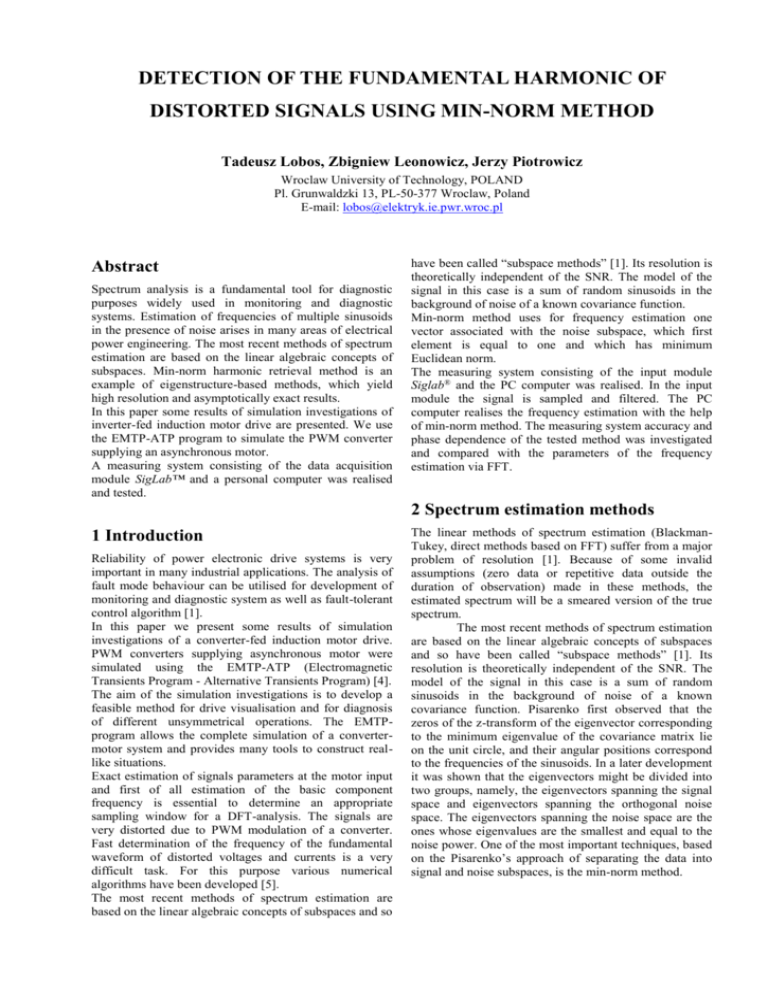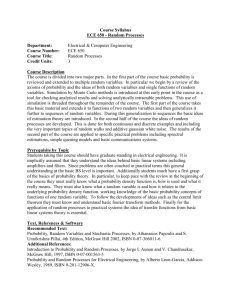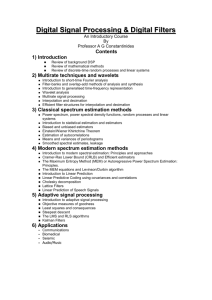FP084
advertisement

DETECTION OF THE FUNDAMENTAL HARMONIC OF DISTORTED SIGNALS USING MIN-NORM METHOD Tadeusz Lobos, Zbigniew Leonowicz, Jerzy Piotrowicz Wroclaw University of Technology, POLAND Pl. Grunwaldzki 13, PL-50-377 Wroclaw, Poland E-mail: lobos@elektryk.ie.pwr.wroc.pl Abstract Spectrum analysis is a fundamental tool for diagnostic purposes widely used in monitoring and diagnostic systems. Estimation of frequencies of multiple sinusoids in the presence of noise arises in many areas of electrical power engineering. The most recent methods of spectrum estimation are based on the linear algebraic concepts of subspaces. Min-norm harmonic retrieval method is an example of eigenstructure-based methods, which yield high resolution and asymptotically exact results. In this paper some results of simulation investigations of inverter-fed induction motor drive are presented. We use the EMTP-ATP program to simulate the PWM converter supplying an asynchronous motor. A measuring system consisting of the data acquisition module SigLab™ and a personal computer was realised and tested. have been called “subspace methods” [1]. Its resolution is theoretically independent of the SNR. The model of the signal in this case is a sum of random sinusoids in the background of noise of a known covariance function. Min-norm method uses for frequency estimation one vector associated with the noise subspace, which first element is equal to one and which has minimum Euclidean norm. The measuring system consisting of the input module Siglab® and the PC computer was realised. In the input module the signal is sampled and filtered. The PC computer realises the frequency estimation with the help of min-norm method. The measuring system accuracy and phase dependence of the tested method was investigated and compared with the parameters of the frequency estimation via FFT. 2 Spectrum estimation methods 1 Introduction Reliability of power electronic drive systems is very important in many industrial applications. The analysis of fault mode behaviour can be utilised for development of monitoring and diagnostic system as well as fault-tolerant control algorithm [1]. In this paper we present some results of simulation investigations of a converter-fed induction motor drive. PWM converters supplying asynchronous motor were simulated using the EMTP-ATP (Electromagnetic Transients Program - Alternative Transients Program) [4]. The aim of the simulation investigations is to develop a feasible method for drive visualisation and for diagnosis of different unsymmetrical operations. The EMTPprogram allows the complete simulation of a convertermotor system and provides many tools to construct reallike situations. Exact estimation of signals parameters at the motor input and first of all estimation of the basic component frequency is essential to determine an appropriate sampling window for a DFT-analysis. The signals are very distorted due to PWM modulation of a converter. Fast determination of the frequency of the fundamental waveform of distorted voltages and currents is a very difficult task. For this purpose various numerical algorithms have been developed [5]. The most recent methods of spectrum estimation are based on the linear algebraic concepts of subspaces and so The linear methods of spectrum estimation (BlackmanTukey, direct methods based on FFT) suffer from a major problem of resolution [1]. Because of some invalid assumptions (zero data or repetitive data outside the duration of observation) made in these methods, the estimated spectrum will be a smeared version of the true spectrum. The most recent methods of spectrum estimation are based on the linear algebraic concepts of subspaces and so have been called “subspace methods” [1]. Its resolution is theoretically independent of the SNR. The model of the signal in this case is a sum of random sinusoids in the background of noise of a known covariance function. Pisarenko first observed that the zeros of the z-transform of the eigenvector corresponding to the minimum eigenvalue of the covariance matrix lie on the unit circle, and their angular positions correspond to the frequencies of the sinusoids. In a later development it was shown that the eigenvectors might be divided into two groups, namely, the eigenvectors spanning the signal space and eigenvectors spanning the orthogonal noise space. The eigenvectors spanning the noise space are the ones whose eigenvalues are the smallest and equal to the noise power. One of the most important techniques, based on the Pisarenko’s approach of separating the data into signal and noise subspaces, is the min-norm method. d 3 Min-norm method The min-norm method [1] involves projection of the signal vector: si 1 e j i e j N 1 i T (1) 1 E noisec ' *T c c E noisec / c c 1 *T Pseudospectrum defined with the help of d is defined as. P e j 1 w *T d 2 1 w dd *T w where w is defined as in (1). We consider a random sequence x made up of M independent signals in noise. 4 SigLab® signal analyser M i 1 Ai Ai e ji (2) If the noise is white, the correlation matrix is R x Ai Ai s i s iT 02 I M (3) i 1 N-M smallest eigenvalues of the correlation matrix (matrix dimension N>M+1) correspond to the noise subspace and M largest (all greater than 02 ) corresponds to the signal subspace. We define the matrix of eigenvectors: E noise e M 1 e M 2 e N (4) Min-norm method uses one vector d for frequency estimation. This vector, belonging to the noise subspace, has minimum Euclidean norm and his first element equal to one. These conditions are expressed by the following equations T d E noiseE*noise d (5) d *T 1 We can express (5) in one equation T d *T E noiseE *noise d and form the lagrangian *T T d *T E noiseE *noise 1 (6) T L d *T d 1 d *T E noiseE*noise T * 1 T E noiseE*noise d (7) Gradient of (7) has the form T d* L = d E noiseE*noise 0 (8) where is chosen in such way that the first element of the vector is equal to one. For this purpose we present E noise in the form E noise where c cE *T (11) *T onto the entire noise subspace. x Ai s i ; (10) SigLab® [6] is a very good tool for signal analysis and signal processing in electrical engineering. It forms with the PC computer an universal set of virtual instruments realising also the hardware DFT and digital filtering. SCSI interface assures fast and reliable communication between the computer and signal analyser. SigLab® is also fully integrated with Matlab® programming environment. The key advantage of the SigLab/Matlab integration is the ability to address unique application requirements by programming SigLab within Matlab environment [6]. The creation of complex applications with graphical user interface requires significant programming work in any environment. Matlab has three significant advantages over the mainstream (C++, Visual Basic, etc.) environments for engineering applications: sophisticated array and vector calculations are easy, extensive visualisation capabilities, good graphical interface tools. The six virtual instruments allow measurements to be made on dynamic signals and systems directly in the Matlab environment. The results of these measurements can be loaded directly to the Matlab programs. There are six virtual instruments implemented using Matlab GUI tools and the SigLab/Matlab interface routines. vos oscilloscope, vfg – function generator (periodic and arbitrary signals), vsa - spectrum analyser (FFT-based spectrum estimation), vna – network analyser , vid – system identification, vss – swept sine analyser. Matlab programming environment and interface routines allow creation of user-programmed applications. This possibility was used to create the described application (Fig. 1). In the input module SigLab the signal is sampled and filtered. The PC computer realises the frequency estimation with the help of min-norm method and visualises the spectrum estimate. Min-norm spectrum estimate c *T ' E noise (9) is the upper row of the matrix. Hence *T noise . From (8) and (9) results that the first element of the vector d is equal to c*T c . End Finally, vector d is equal to Figure 1. The window of the spectrum estimation by minnorm method. 5 Drive simulation In the recent years, simulation programs for complex electrical circuits and control systems have been improved essentially. The simulation of characteristic transient phenomena concerning the electrical quantities became feasible without any arrangement of hardware. Beside of a lot of disposable simulation programs, the EMTP-ATP (Electromagnetic Transients Program Alternative Transients Program) as a FORTRAN based and to MS-DOS/WINDOWS adapted program serves for modelling complex 1- or 3-phase networks occurring in drive, control and energy systems. In the paper we show investigation results of a 3kVAPWM-converter with a modulation frequency of 1 kHz supplying a 2-pole, 1 kW asynchronous motor (U=380 V, I=2.8 A) (Fig.3). Characteristic RC-damping components at the rectifier bridge and at the converter valves are considered. To design the intermediate circuit, the L, C values of a typical 3-kVA converter are chosen. EMTPATP ensures to elaborate the structure variably, therefore extremely high switching frequency (up to 1 MHz) are possible. The sampling window and the step width have been aligned optimally to the current frequency in a way that at least one rotation of the rotating space-phasor was guaranteed ( T 5.0 10 5 s and Tmax 5.0 10 2 ). The simulated converter can change the output frequency within a range 0.1-150 Hz. Fig.4 shows current waveform at the converter output for the frequency 60 Hz. PWM L 3f ~ C L Figure 2. Simplified scheme of the simulated converter configuration. period T 1 103 s ten estimating processes were carried out. The estimated frequency was in the range 59,5061.27 Hz (mean 60.24 Hz) (Fig. 5). The objective of the next experiment is to evaluate the phase dependence of the proposed measuring system in comparison to the traditional Fourier power spectrum of the signal [5]. We performed one hundred trials for each case. Each experiment is based on the window displaced by one data sample, and this process is repeated one hundred times. In order to establish the actual dependence of the estimates on the window length and not be limited by the number of frequency bins, spectral interpolation was produced by zero-padding the sequences. 3 2 current [A] 1 0 -1 -2 61.4 -3 0 0.02 0.04 0.06 0.08 61.2 0.1 time [s] 61 60.8 Figure 3. Current waveform at the converter output. 60.6 f [Hz] 60.4 60.2 6 Investigation results The estimation accuracy of the proposed measurement system has been examined for various waveform distortions. Owing to limited space we shall present only some investigation results regarding the current waveforms at the motor input for the frequency equal to ca 60 Hz, as shown in the Fig. 4. The first estimation was made applying 100 samples of the investigated waveform. After obtaining the first results, the sampling window was moved at 10 samples and so on. Applying the sampling 60 59.8 59.6 59.4 1 2 3 4 5 6 7 8 9 10 11 estimation number Figure 4. Estimation of the fundamental frequency by min-norm method. Figures 6 and 7 present the spectral estimation results. Each of the frequency bins is approximately equivalent to 1 Hz ( sampling frequency 100) Hz, 1024-point FFT). The phase of the distorted signal has significantly lower influence on the estimation accuracy in the case of the min-norm method. We obtained the exact estimation result in 54% for min-norm method and only in 15% for traditional FFT-based method. 25 20 15 7 Conclusions The exact estimation of the frequency of distorted currents is necessary for the purpose of observation and diagnosis of inverter motor drives. It was shown that high-resolution spectrum estimation method, such as minnorm could be effectively used for parameter estimation of the fundamental component of distorted signals. The frequency estimation enables to calculate the stationary space-phasor and to determine an appropriate window for a DFT-analysis The accuracy of the estimation method depends on the signal distortion, the sampling window and on the number of samples taken into the estimation process. Computer simulation results confirm the validity and performance of the proposed method. 10 5 8 References 0 54 58 59 60 f [Hz] 61 62 63 Figure 5. Histogram of the spectral estimates (power spectrum). 60 50 40 30 20 10 0 57 58 59 60 f [Hz] 61 62 63 Figure 6. Histogram of the spectral estimates (min-norm). [1] Therrien C.W., Discrete Random Signals and Statistical Signal Processing, Englewood Cliffs, New Jersey, Prentice-Hall, 1992, pp. 614-655. [2] Naidu P.S., Modern Spectrum Analysis of Time Series, Boca Raton, Florida, CRC Press, 1996, pp. 241-336. [3] Łobos T., Ruhm D., Wacławek Z. Adaptive Neural Networks for Signal Analysis in Converter-Fed Induction Motor Drive, Proc. International Conference on Systems, Signals, Control, Computers (SSCC ’98), South Africa, Sept. 1998, pp. 208-214. [4] EMTP Rule Book, Alternative Transients Rulebook, Canadian/American EMTP User Group, 1987-1992. [5] Velez E., Absher R. Spectral Estimation Based on the Wigner-Ville Representation, Signal Processing, 1990, Vol. 20, No. 4, pp. 325-346. [6] SigLab Users Guide, DSP Technology Corp., USA, 1994









